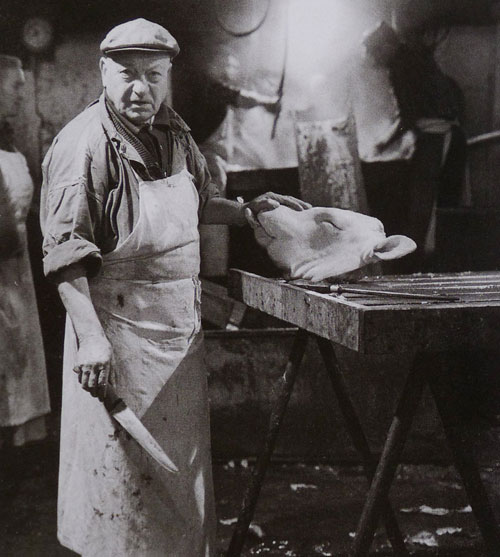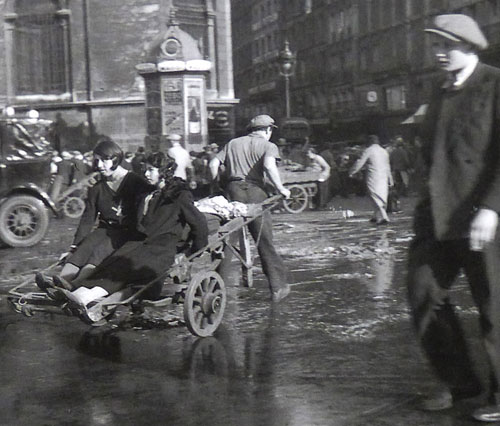A Blockbuster Photo Show: When Robert Doisneau Used His Rolleiflex to Document “Paris les Halles”
posted Friday, April 20, 2012 at 3:27 PM EDT
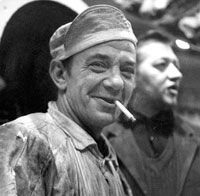 Every day, there is a long queue snaking around the block of the Hôtel de Ville (City Hall) in central Paris. Looking like a line for rock concert tickets or the latest Harry Potter book, it is actually the people waiting to see a show of photographs, "Doisneau, Paris les Halles."
Every day, there is a long queue snaking around the block of the Hôtel de Ville (City Hall) in central Paris. Looking like a line for rock concert tickets or the latest Harry Potter book, it is actually the people waiting to see a show of photographs, "Doisneau, Paris les Halles."
This exhibition of over 200 images by photographer Robert Doisneau has been packed since its opening in February, evidence that the show has struck a responsive chord in the hearts of the city’s otherwise jaded denizens. It is a lovely tribute to a slight, unassuming man, with a big heart and a big smile.
Doisneau is best known for his photo of two lovers kissing on the street "The Kiss," which ironically was taken in front of the very site of the show. His images capture a Paris of the past, a loud, boisterous, risqué, yet sentimental, funny place. A photographer in love with his city, he took over 400,000 images of Paris, photographing up to his death in 1994.
Driven by a thirst for images, Doisneau roamed the streets of Paris with his twin-lens Rolleiflex, often shooting under the worst conditions in dim cafes and on dark rainy streets. He documented all classes of Parisians, from tired workers in smoke filled cafes, to rich backstage gigolos at the Folies Bergere, to kids playing street games.
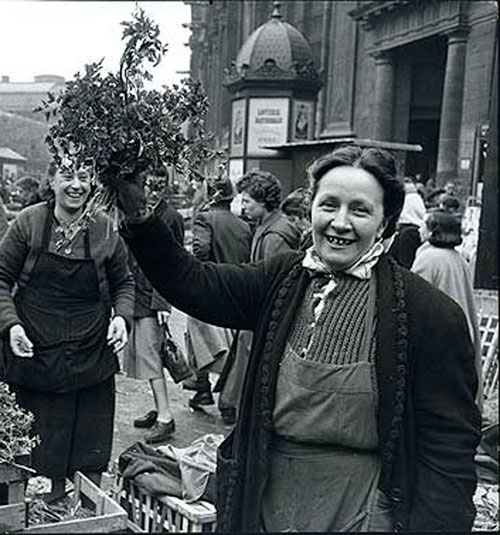 He particularly liked les Halles, the huge covered market in the center of the city. Built in 1866, it was a classic bit of Second Empire architecture with soaring steel arches and glass-paneled roof. He made his first image there in 1933 and continued to photograph its butchers, cafés, vegetable stalls, and fishmongers for nearly 40 years.
He particularly liked les Halles, the huge covered market in the center of the city. Built in 1866, it was a classic bit of Second Empire architecture with soaring steel arches and glass-paneled roof. He made his first image there in 1933 and continued to photograph its butchers, cafés, vegetable stalls, and fishmongers for nearly 40 years.
When in the 1960s, the city decided to raze les Halles, Doisneau worried and angry, knew he had to act. Soon he was photographing les Halles three, or four times a week, shooting in both black-and-white and color. He lived in the Montrouge neighborhood of Paris and described his day as, "So I got up at 3 am, in Montrouge, on my way there, among the workers of the dawn, who unloaded the trucks, those who put the goods in place. Difficult to photograph: lack of light, reflexes slowed by fatigue, so many images as possible! And then it was intimidating. But I got hooked. I knew it would disappear. I really wanted to fix in the memory."
"Doisneau, Paris les Halles" presents those reminiscences of the lost central market to modern Parisians and they are clearly embracing it. In part, it is because, Doisneau’s photographs are warm, rather quiet moments.
Despite his personal anger about the destruction of les Halles, none of his images is angry. Instead, they show people who seem to have stepped out of the market hurly-burly for an instant, lost within their own actions or thought, or just greeting the photographer. Like the lovers in "The Kiss," the power of many of Doisneau’s images lie in this momentary obliviousness of his subjects to the world around them.
Dosineau’s work is central to the collective memory of Paris because for many native Parisians, the show is also a family album, full of the faces of grandparents and friends now long gone.
As one Parisian told a reporter as she left the "Doisneau, Paris les Halles" show: “He is our photographer. We grew up with his pictures. He is our heart.”
"Doisneau, Paris les Halles" is part of the centenary celebration of the photographer’s birth in 1912 and the show runs through April 28, 2012. Admission is free.
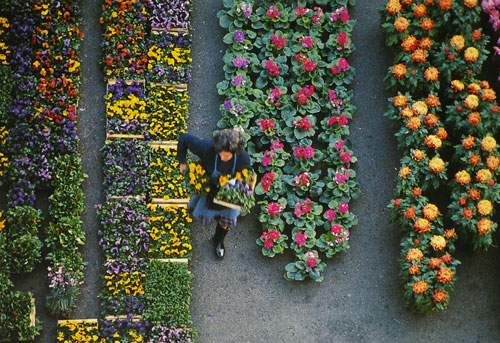 On Dosineau’s birthday, April 14th, Google honored him by turning the Google Doodle into a scrapbook of his images.
On Dosineau’s birthday, April 14th, Google honored him by turning the Google Doodle into a scrapbook of his images.
To see more of Robert Doisneau’s images: www.robert-doisneau.com
